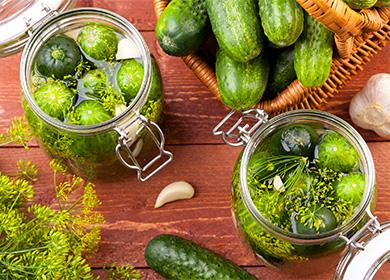Pickles are considered to be a traditional Slavic dish. However, the first attempts to use this method of conservation were made in the third millennium BC. in Mesopotamia and India.
Benefit and harm
Pickled cucumber contains the same nutrients and vitamins as fresh, but in smaller quantities: vitamins A, B1, B2, C, PP, potassium, phosphorus, calcium, iron, zinc and other minerals. It is no coincidence that Columbus stocked them for long voyages to protect sailors from scurvy.
During fermentation, lactic acid is formed in pickles, which has a beneficial effect on the intestinal microflora. The product improves appetite, stimulates intestinal motility and the production of gastric juice.
Eating pickles is not recommended for:
- severe obesity;
- pathologies of the stomach and intestines;
- hypertension
- atherosclerosis;
- kidney disease;
- gallstone disease.
The choice of vegetable ...
Translated from Greek, cucumber means "immature." Indeed, this vegetable is eaten unripe: a fruit with large seeds and flesh with sourness that starts to turn yellow is tasteless and contains less nutrients. Therefore, young pickles are used for pickling. Below are six recommendations for choosing a vegetable.
- The size. Select fruits 9-15 cm long: such specimens are dense and elastic, and easily fit in a jar.
- Skin. It should be dark green and hard, without damage and stains. However, a too thick peel will prevent the brine from penetrating into the vegetable.
- Pimples. The surface of the fruit must necessarily be bumpy, while the tips of the thorns must have black dots, white specks are a sign of a salad variety, which is not recommended for salting.
- Grade. For home preservation, they have proven themselves well: Nezhinsky, Zozulya, Anulka F1, Ira F1, Zakuson F1, Rodnichok, Muromsky, Era, Stage, Nezhinka, “Bochkovoi F1”, “Nightingale”, “Gypsy F1”, “Parisian Gherkin”, “Courage F1”, “Mama’s Favorite F1”, “German”, “Magnificent”, “Crispy”.
- The method of growing. Cucumber, ripened in direct sunlight on the open ground, as a rule, is not bitter and has a more pronounced taste and aroma.
- Taste. It is impossible to “fix” the bitter fruits with the help of salting, therefore, such vegetables cannot be taken for preservation.
... and additional ingredients
Preservation of cucumbers for the winter by the salting method is provided by the ability of sodium chloride to inhibit the growth of pathogenic microorganisms that cause damage to the vegetable. During fermentation, lactic acid is produced, which also prevents the development of rotting bacteria. Salt is recommended to use table, stone. To implement almost all recipes you will need:
- water - well or spring, in extreme cases - bottled or boiled filtered;
- leaves - oak, currant or cherry: not only make the snack aromatic, but also increase its shelf life due to the tannins contained in their composition;
- spices - bay leaf, horseradish leaves, dill umbrellas, black peppercorns.
The proportions of the ingredients are calculated depending on the number of cucumbers. The table below shows the standard set of components for a three-liter jar.
Table - How many ingredients to take
| Component | amount |
|---|---|
| Cucumbers | 1,5 kg |
| Brine | 1,5 l |
| Laurel | 2 pieces |
| Cherry leaf | 2-3 pieces |
| Oak Leaf | 2-3 pieces |
| Blackcurrant leaf | 2-3 pieces |
| Dill umbrella | 2 pieces |
| Garlic | 5-6 cloves |
| Horseradish root (the size of the little finger) | 1-2 pieces |
| Black pepper peas | 10 pieces |
| Hot pepper | 0.5-1 piece |
You can add other spices: mint, tarragon, mustard seeds, savory, basil.
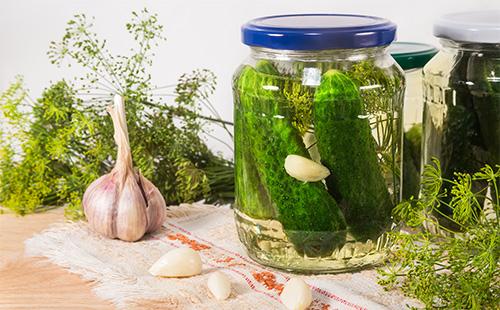
Training
To make the pickles crispy, they must be soaked in cold water for two to seven hours before being preserved. At the same time, it is advisable to pour pieces of ice in a container with a vegetable and put the dish in a cool place. Water needs to be changed every hour. Leaving the cucumbers to soak all night is not worth it: they absorb too much moisture and can “explode” in the process of pickling.
"Ponytails" can not be cut: so the fruits are better kept in shape. But if you do this or pierce the vegetable with a fork, the process of pickling will accelerate.
Before adding to the harvest, garlic must be peeled and chopped with thin plates. Hot peppers can be thrown whole. If you want a more acute taste, cut together with seeds in large pieces. Rinse leaves and greens well with running water and dry.
Culinary nuances
In one container, you need to pickle cucumbers of approximately the same size, otherwise some fruits will turn out to be under-salted, others will be over-salted. Three more secrets that will help novice housewives stock up on delicious billets.
- The freshness of the fruit. It is recommended to pickle cucumbers on the day of harvest. If a product is bought on the market, it remains only to rely on the honesty of the seller.
- Sterilization. Banks in which the vegetable will be salted, rinse with soda and sterilize in any way. If preservation takes place in a wooden tub or in an enameled bowl, wash the container with laundry soap or soda.
- Bookmark Fresh fruits are stacked in jars or another container vertically, tightly, but do not need to be tightly packed. Spices must be laid out on the bottom of the dish and on top of the cucumbers, you can place them between the fruits.
How to salt cucumbers for the winter: 3 methods
Filling is traditionally carried out in two ways: cold or hot. The recipe for brine for cucumbers is the same: two or two and a half tablespoons of salt per liter of water, only in the first case, the liquid is taken at room temperature, in the second, boiling water is used.
Hot
Features You can stock up on crispy pickles for the winter using the hot method, the recipe of which is described below. The workpiece will be ready faster than with the cold method.
You will need:
- cucumbers
- water;
- salt;
- spices and leaves.
How to cook
- Put cucumbers together with spices in a large enameled pan or bucket.
- Boil water, add salt (60 g per liter).
- Pour cucumbers with a hot solution so that the liquid completely covers them.
- Set oppression, withstand at room temperature for five days.
- Drain the brine, boil and pour the cucumbers again.
- Wait for the workpiece to cool completely, put it in the jars and roll up the varnished (tin) lids.
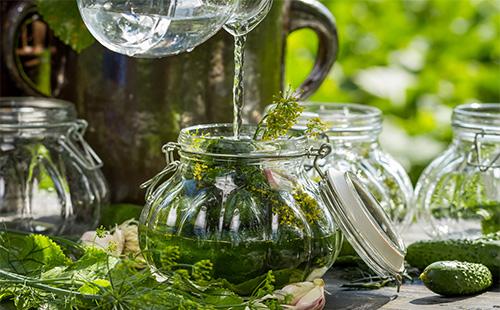
Cold
Features It is considered the most common method of preserving a pimply vegetable.This is due to its simplicity and the ability to save most of the nutrients contained in the product.
You will need:
- cucumbers
- water;
- salt;
- leaves and spices.
How to cook
- Put spices and cucumbers in jars so that about 5-7 cm of empty space is left up to the neck.
- Prepare a brine at the rate of 50-60 g of salt per liter of water. It is advisable to first dissolve sodium chloride in half a glass of hot water, then pour in ice water. Strain through cheesecloth folded in several layers.
- Pour the brine into cans with cucumbers to the brim, sprinkle with mustard powder on top.
- Cover the containers with gauze and stand for one to two days at room temperature. During this period, fermentation occurs, which is accompanied by the formation of lactic acid necessary for preservation: foam appears, brine becomes cloudy.
- Move the workpiece to a cold place with a temperature of about −5-1 ° C for another 10-12 days. The fermentation process will slow down, and the cucumbers will turn out juicy, without voids. Instead, you can withstand the workpiece at a temperature of 17 ° C for eight days. If necessary, add brine: cucumbers should always be covered with liquid.
- When the fermentation process is completed, the brine will become transparent and the foam will disappear, pour brine into the cans to the top and close with plastic lids. If you preheat the capron lids in hot water, when cooled, they "sit" tightly on a jar.
Fast
Features A quick way to make salted cucumbers, which will be ready in two to three hours, without brine. True, preserving them for the whole winter will not work, the shelf life of the billet is two to three days in the refrigerator.
You will need:
- cucumbers
- salt;
- garlic;
- sprigs of dill.
How to cook
- Chop the cucumbers in circles or divide into four parts, cutting the fruits along.
- Chop dill coarsely, chop the garlic in plates or small cubes.
- Put all the ingredients in a plastic bag and salt. Take salt as much as it would take for a salad of fresh cucumbers or a little more.
- Tie a bag and shake it well so that the juice comes out.
- Keep the workpiece in the refrigerator for two to three hours.
Pickling Options
It is easier for novice housewives to step by step follow the recipes described above. Once the classical methods are mastered, you can proceed to the gastronomic experiments: a small change in technology can significantly affect the taste of the workpiece. The following are methods that will help unconventionally salt cucumbers for the winter.
Hot advanced
- Put leaves, spices and cucumbers in jars.
- Pour boiling water without salt, cover with varnished lids and a terry towel.
- After two to three minutes, using gauze, drain the liquid.
- Pour boiling water over the cucumbers again for five to six minutes, drain the water.
- Pour hot brine into the container (30-35 g of sodium chloride per liter of water), roll up and cool as soon as possible.
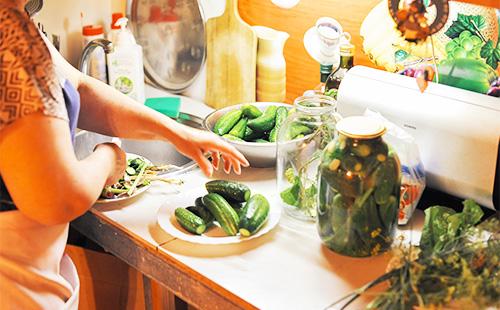
Cold long
- Make salting in accordance with a traditional recipe.
- Immediately transfer the workpiece to a cool place without leaving it warm.
- Preserve the month.
Mixed
- Pour cucumbers with cold brine, stand for three days in a warm room.
- Drain and boil the liquid, and rinse the cucumbers and put them in jars.
- Pour in hot brine.
- Pour three or four tablespoons of vodka into each three-liter jar, roll up.
What else to add
A classic set of spices can be complemented by other ingredients that make the workpiece original. Note six ideas.
- Apples Two or three fruits of sweet and sour varieties cut into slices and put in a container with cucumbers.
- White bread. Cut into large pieces 200 g and lay on the bottom of the jar. Use with hot salting.
- Vodka. Take 50 ml of the product for each three-liter jar. When harvesting pickles for winter with vodka using the cold method, the ingredient is poured into brine.
- Oak bark. Throw a small piece into the pickle bowl to make the cucumbers crispy.
- Vinegar. In a cold way, cucumbers need to be salted without vinegar. When hot, this ingredient can be added (three tablespoons per 1.5 liters of water) along with sugar (one and a half tablespoons). In this case, the amount of salt is reduced to one and a half tablespoons.
- Lemon acid. For stomach problems, it is better to harvest pickles without vinegar for the winter. Citric acid, which is added during the hot method after pouring the brine (a teaspoon on a three-liter jar), will help to acidify the workpiece. A sour taste of cucumbers can provide a slice of lemon, thrown in a jar.
Ideas for submission
Harvesting is good as an independent snack, in combination with potatoes and other vegetable dishes. But there are countless dishes in which pickled cucumber is used as one of the main ingredients, here are three of them.
Salad
- Boil 300 g of chicken and chop into strips, chop two pickles, grate 50 g of hard cheese, crush two cloves of garlic with a press.
- Boil two eggs, separate the proteins from the yolks. Coarsely rub the proteins, grind the yolks with a fork.
- Put the ingredients in a salad bowl in layers, smearing each with mayonnaise: a can of canned green peas, yolk, protein mixed with garlic, cheese, chicken, cucumbers.
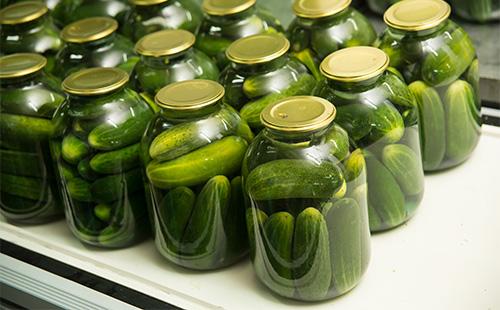
Pickle
- Cook the meat broth. Remove and cut the meat into small cubes.
- Using a coarse grater to process 300 g of pickles.
- Chop the onion finely, process the carrots with a coarse grater, fry vegetables in vegetable oil until transparent.
- Stir the meat and fry for another two to three minutes.
- Pour half the prepared cucumbers and pickle from them into the pan, fry them for one or two minutes, turn off the stove.
- Boil the broth, add two or three tablespoons of rice to the pan, wait for the boil to boil again.
- After five to seven minutes add the roast, after boiling, reduce the heat.
- After five to seven minutes, introduce one or two diced potatoes.
- After boiling for five minutes, pour the remaining cucumbers.
- After a quarter of an hour, add garlic, crushed by the press, and finely chopped greens to taste.
- After a minute, turn off the stove, wrap the pan with a blanket and insist on the soup for 20-30 minutes.
Roll
- Coat a sheet of pita bread with mayonnaise.
- Coarsely chop 250 g of pickled mushrooms.
- Process with a coarse grater 100 g of hard cheese and three pickles.
- Grind the onion, a bunch of dill and one or two cloves of garlic.
- Stir the ingredients.
- Put the filling on pita bread, roll.
- Soak in the refrigerator for an hour, cut into slices.
The recipe for pickles for the winter can be original due to the spices used. The workpiece is stored in a cool place for two years. If preservation occurs in barrels or an enameled vessel, the storage time is reduced to six to eight months.
Other salad recipes
Korean cucumbers
Mustard Pouring Cucumbers
Carrot salads for the winter
Stuffed pepper
